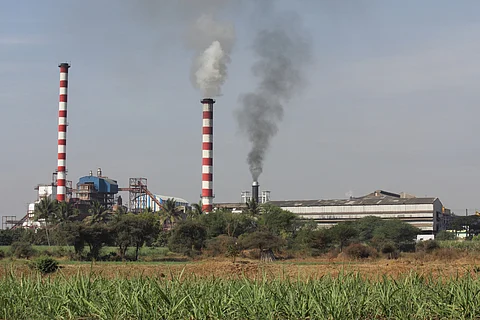

A new study found that the world’s first market for trading in particulate matter emissions, launched in Gujarat’s Surat, delivered both environmental and economic benefits. The programme lowered industrial pollution, slashed abatement costs for plants and improved compliance with environmental regulations.
Published in the May 2025 issue of The Quarterly Journal of Economics and released on April 15, 2025 , the study evaluated the emissions trading scheme (ETS), a cap-and-trade system for particulate pollution. The programme, operational for over five years, was the first of its kind globally for particulate matter and India’s first pollution trading scheme of any kind.
Using a randomised controlled trial in Surat — a major industrial hub — researchers found that the market-based programme reduced particulate emissions by 20 to 30 per cent. Pollution abatement costs dropped by over 10 per cent, and compliance with environmental laws rose to 99 per cent among participating plants.
Air pollution remains one of the gravest public health risks in India, with some research suggesting the average Indian loses over 5 years of their life expectancy due to air pollution exposure.
The Surat ETS is the world’s first particulate-emissions market and India’s first market for any pollutant. It was developed as a pilot by the Gujarat Pollution Control Board (GPCB), in collaboration with the Energy Policy Institute at the University of Chicago.
Under the programme, 318 large coal-using industrial plants were required to install Continuous Emissions Monitoring Systems (CEMS), allowing real-time tracking of particulate matter emissions. This marked a shift from the earlier system of periodic spot checks.
GPCB set an overall cap on the total mass of particulates that could be emitted collectively by all plants over a compliance period. Plants were either allocated or allowed to buy emissions permits, each granting the right to emit 1 kilogramme of particulate matter.
Up to 80 per cent of the total cap was distributed for free, proportional to a plant’s emissions potential. The remaining 20 per cent were auctioned off weekly. The plants could then trade these permits, creating a financial incentive to reduce emissions where it was cheapest to do so.
Any firm that failed to hold sufficient permits to cover its emissions at the end of a compliance period faced penalties based on the size of the shortfall.
Initially, GPCB capped total particulate emissions at 280 tonnes per month. According to the study, “This cap was an approximation that assumed plants would run at the maximum available capacity and produce emissions at the maximum concentration allowed under the status quo the whole time.”
As real-time data from CEMS became available, GPCB realised the cap was set too high and revised it downward in stages, eventually settling at 170 tonnes per month.
The evaluation, conducted by Michael Greenstone from University of Chicago, Rohini Pande and Nicholas Ryan of Yale University and Anant Sudarshan from University of Warwick, ran from September 2019 to April 2021. The period included a disruption caused by the nationwide COVID-19 lockdown.
A total of 162 out of 317 plants were randomly assigned to participate in the trading market, while 155 served as a control group under existing command-and-control regulations. Across 10 compliance periods — each lasting between four and six weeks — GPCB compared status quo measurements taken during periodic spot visits to the plants.
The study found that market participants reduced emissions by 20 to 30 per cent. These plants, if they held enough permits to cover their emissions, complied with permit requirements 99 per cent of the time, compared to just 66 per cent among non-participating plants.
The emissions reduction stemmed both from the initial cap being stricter than previous regulations and from the regulator’s decision to tighten the cap further over time, the authors of the paper noted.
Participating plants also spent 11 per cent less on pollution abatement compared to those under standard regulatory mechanisms. The researchers estimated that the benefits of the market-based approach outweighed its costs by a factor of at least 25.
“The exciting part of the ETS that we did for particulate matter,” Rohini Pande said, “aside from reducing emissions, is that it provides a proof of concept that even in a setting with lower state capacity, a compliance market can work and often will outperform the command-and-control approach.”